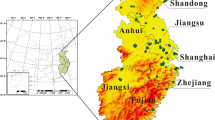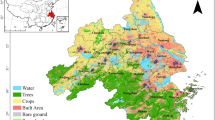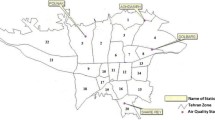Abstract
Ground monitoring station data of PM2.5 are not available for each day and all places in urban areas. In this research, taking Tehran as an example, a geographically and temporally weighted regression (GTWR) model was utilized to investigate the spatial and temporal variability relationship between PM2.5 concentrations measured at ground monitoring stations and satellite aerosol optical depth (AOD) data. The Moderate Resolution Imaging Spectroradiometer (MODIS) sensor produced AOD values with 3-km spatial resolution. Using meteorological variables and land use information as additional predictors utilized in the GTWR model, the AOD was converted to PM2.5 at ground level for warm (October to March) and cold seasons (April to September) from 2011 to 2017. To improve the accuracy of the correlation coefficient between converted PM2.5 from the GTWR model and PM2.5 concentrations measured at ground monitoring station, the results of a linear model (LR), a nonlinear model (artificial neural network (ANN)), and hybrid models including general regression neural network (GRNN) and adaptive neuro-fuzzy inference system (ANFIS) were compared. The results of the linear, nonlinear, and hybrid models for the cold season display higher accuracy compared with the results for the warm season. Among the used models, the GRNN model has higher accuracy compared with the other models. This study reveals that AOD conversion to particulate matter by the GTWR model and its simulation to PM2.5 at ground level using a hybrid model such as the GRNN can be used to study air quality.









Similar content being viewed by others
References
Alimissis A, Philippopoulos K, Tzanis CG, Deligiorgi D (2018) Spatial estimation of urban air pollution with the use of artificial neural network models. Atmos Environ 191:205–213
Amanollahi J, Kaboodvanpour S, Abdullah AM, Ramli MF (2011) Accuracy assessment of moderate resolution image spectroradiometer products for dust storms in semiarid environment. Int J Environ Sci Technol 8(2):373–380
Amanollahi J, Tzanis C, Abdullah AM, Ramli MF, Pirasteh S (2013) Development of the models to estimate particulate matter from thermal infrared band of Landsat Enhanced Thematic Mapper. Int J Environ Sci Technol 10(6):1245–1254
Amanollahi J, Kaboodvandpour SH, Qhavami S, Mohammadi B (2015) Effect of the temperature variation between Mediterranean Sea and Syrian deserts on the dust storm occurrence in the western half of Iran. Atmos Res 154:116–125
Amirkhani S, Nasirivatan S, Kasaeian AB, Hajinezhad A (2015) ANN and ANFIS models to predict the performance of solar chimney power plants. Renew Energy 83:597–607
Ansari M, Ehrampoush MH (2019) Meteorological correlates and AirQ+ health risk assessment of ambient fine particulate matter in Tehran. Iran Environ Res 170:141–150
Antonopoulos VS, Papamichail DM, Aschonitis VG, Antonopoulos AV (2019) Solar radiation estimation methods using ANN and empirical models. Comput Electron Agric 160:160–167
Anusree A, Varrghese KO (2016) Stream flow prediction of Karuvannur river basin using ANFIS, ANN, and MNLR models. Proc Technol 24:101–108
Arora S, Keshari A (2018) Estimation of re-aeration coefficient using MLR for modelling water quality of rivers in urban environment. Ground Water Sustain Dev 7:430–435
Ausati S, Amanollahi J (2016) Assessing the accuracy of ANFIS, EEMD-GRNN, PCR, and MLR models in predicting PM2.5. Atmos Environ 142:465–474
Brooks N, Legrand M (2000) Dust variability over northern Africa and rainfall in the Sahel. In: McLaren S, Kniveton D (eds) Linking climate change to land surface change. Springer, New York, pp 1–25
Delle Monache L, Perry KD, Cederwall RT (2002) Comparison of aerosol properties within and above the ABL at the ARM program’s SGP site. Proceedings AMS conference on the application of air pollution meteorology 2002, Norfolk, Virginia, pp. 78–80
Faridi S, Shamsipour M, Krzyzanowski M, Künzli N, Amini H, Azimi F, Malkawi M, Momeniha F, Gholampour A, Hassanvand MS, Naddafi K (2018) Long-term trends and health impact of PM2.5 and O3 in Tehran, Iran, 2006–2015. Environ Int 114:37–49. https://doi.org/10.1016/j.envint.2018.02.026
Fernando HJ, Mammarella MC, Grandoni G, Fedele P, Di Marco R, Dimitrova R et al (2012) Forecasting PM10 in metropolitan areas: efficacy of neural networks. Environ Pollut 163:62–67
Franceschi F, Cobo M, Figueredo M (2018) Discovering relationships and forecasting PM10 and PM2.5 concentrations in Bogotá, Colombia, using artificial neural networks, principal component analysis, and k-means clustering. Atmos Pollut Res 9(5):912–922
Ghasemi A, Amanollahi J (2019) Integration of ANFIS model and forward selection method for air quality forecasting. Air Qual Atmos Health 12(1):59–72
Guneri AF, Ertay T, Yücel A (2011) An approach based on ANFIS input selection and modeling for supplier selection problem. Expert Syst Appl 38(12):14907–14917
Guo Y, Tang Q, Gong D-Y, Zhang Z (2017) Estimating ground-level PM2.5 concentrations in Beijing using a satellite-based geographically and temporally weighted regression model. Remote Sens Environ 198:140–149
He Q, Huang B (2018a) Satellite-based mapping of daily high-resolution ground PM2.5 in China via space-time regression modeling. Remote Sens Environ 206:72–83
He Q, Huang B (2018b) Satellite-based high-resolution PM2.5 estimation over the Beijing-Tianjin-Hebei region of China using an improved geographically and temporally weighted regression model. Environ Pollut 236:1027–1037
Hu X, Waller LA, Al-Hamdan MZ, Crosson WL, Estes MG, Estes SM et al (2013) Estimating ground-level PM2.5 concentrations in the southeastern US using geographically weighted regression. Environ Res 121:1–10
Hu X, Waller LA, Lyapustin A, Wang Y, Al-Hamdan MZ, Crosson WL et al (2014a) Estimating ground-level PM2.5 concentrations in the Southeastern United States using MAIAC AOD retrievals and a two-stage model. Remote Sens Environ 140:220–232
Hu X, Waller LA, Lyapustin A, Wang Y, Liu Y (2014b) 10-year spatial and temporal trends of PM2.5 concentrations in the southeastern US estimated using high-resolution satellite data. Atmos Chem Phys 14:6301–6314
Huang M, Peng G, Zhang J, Zhang S (2006) Application of artificial neural networks to the prediction of dust storms in Northwest China. Glob Planet 52(1-4):216–224
Huang R, Zhai X, Lvey CE, Friberg MD, Hu X, Liu Y, Di Q, Schwartz J, Moulholland JA, Russell AG (2018) Air pollutant exposure field modeling using air quality model-data fusion methods and comparison with satellite AOD-derived fields: application over North Carolina, USA. Air Qual Atmos Health 11(1):11–22
IPCC (2007) IPCC Fourth Assessment Reports (AR4): Working Group I Report: Climate Change 2007, the Physical Basis (WMO/UNEP Report)
Kaboodvandpour S, Amanollahi J, Qhavami S, Mohammadi B (2015) Assessing the accuracy of multiple regressions, ANFIS, and ANN models in predicting dust storm occurrences in Sanandaj, Iran. Nat Hazards 78(2):879–893
Karagulian F, Temimi M, Ghebreyesus D, Weston M, Kondapalli NK, Valappli VK, Aldabesh A, Lyapustin A, Chaouch N, Hammadi FA, Abdooli AA (2019) Analysis of a severe dust storm and its impact on air quality condition using WRF-Chen modeling, satellite imagery, and ground observations. Air Qual Atmos Health 12(4):453–470
Kaufman YJ, Tanre D, Boucher O (2002) A satellite view of aerosols in climate systems. Nature 419:215–223
Legates DR, McCabe GJ (1999) Evaluating the use of “goodness-of-fi” measures in hydrologic and hydroclimatic model validation. Water Res 35(1):233–241
Leng X, Wang J, Ji H, Wang Q, Li H, Qian X, Li F, Yang M (2017) Prediction of size-fractionated airborne particle-bound metals using MLR, BP-ANN and SVM analyses. Chemosphere 180:513–522
Leung MT, Daock H, Chen A (2000) Forecasting stock indices: a comparison of classification and level estimation models. Int J Forecast 16(2):173–190
Li T, Shen H, Zeng C, Yuan Q, Zhang L (2017) Point-surface fusion of station measurements and satellite observations for mapping PM2.5 distribution in China: Methods and assessment. Atmos Environ 152:477–489
Lin J, Sheng G, Yan Y, Dai J, Jiang X (2018) Prediction of dissolved gas concentrations in transformer oil based on the KPCA-FFOA-GRNN model. Energies 11(1):255. https://doi.org/10.3390/en11010225
Liu Y (2008) The application of satellite remote sensing in estimating fine particle concentration. PhD thesis, Harvard University, 113 pp
Ma Z, Hu X, Huang L, Bi J, Liu Y (2014) Estimating ground-level PM2.5 in China using satellite remote sensing. Environ Sci Technol 48(13):7436–7444
MATLAB (2019) ANFIS and the ANFIS Editor, Available at: https://www.mathworks.com/help/fuzzy/index.html
Mirzaei R, Mesdaghinia A, Hoseini SS, Yunesian M (2019) Antibiotics in urban wastewater and rivers of Tehran, Iran: consumption, mass load, occurrence, and ecological risk. Chemosphere 221:55–66
Nizar S, Dodamani BM (2019) Spatiotemporal distribution of aerosols over the Indian subcontinent and its dependence on prevailing meteorological conditions. Air Qual Atmos Health 12(4):503–517
Noori R, Hoshyaripour G, Ashrafi K, NadjarArrabi B (2010) Uncertainty analysis of developed ANN and ANFIS model in prediction of carbon monoxide daily concentration. Atmos Environ 44:476–482
Park S, Kim M, Kim M, Namgung H-G, Kim K-T, Cho KH, Kwon S-B (2018) Predicting PM10 concentration in Seoul metropolitan subway stations using artificial neural network (ANN). J Hazard Mater 341:75–82
Patra AK, Gautam S, Majumdar S, Kumar P (2016) Prediction of particulate matter concentration profile in an opencast copper mine in India using an artificial neural network model. Air Qual Atmos Health 9(6):697–711
Quan J, Zhang X, Zhang Q, Guo J, Vogt RD (2008) Importance of sulfate emission to sulfur deposition at urban and rural sites in China. Atmos Res 89(3):283–288
Radojevic D, Antanasijevic D, Peric-Grujic A, Ristic M, Pocajt V (2019) The significance of periodic parameters for ANN modeling of daily SO2 and NOX concentrations: a case study of Belgrade, Serbia. Atmos Pollut Res 10(2):621–628
Seinfeld JH, Pandis SN (1998) Atmospheric chemistry and physics-from air pollution to climate change. John Wiley and Sons 1326p
Shahbazi H, Hassani A, Hosseini V (2019) Evaluation of Tehran clean air action plan using emission inventory approach. Urban Clim 27:446–456
Song W, Jia H, Huang J, Zhang Y (2014) A satellite-based geographically weighted regression model for regional PM2.5 estimation over the Pearl River Delta region in China. Remote Sens Environ 154:1–7
Suleiman A, Tight MR, Quinn AD (2019) Applying machine learning methods in managing urban concentrations of traffic-related particulate matter (PM10 and PM2.5). Atmos Pollut Res 10(1):134–144
Taghvaee S, Sowlat MH, Diapouli E, Manouskas ML, Vasilatou V, Eleftheriadis K, Sioutas C (2019) Source apportionment of the oxidative potential of fine ambient particulate matter (PM2.5) in Athens, Greece. Sci Total Environ 653:1407–1416
Titidezh V, Arefi M, Taghaddosinejad F, Behnoush B, Akbarpour S, Mahboobi M (2019) Epidemiologic profile of deaths due to drug and chemical poisoning in patients referred to Baharloo hospital of Tehran, 2011 to 2014. J Forensic Legal Med 64:31–33
Tzanis CG, Alimissis A, Philippopoulos K, Deligiorgi D (2019) Applying linear and nonlinear models for the estimation of particulate matter variability. Environ Pollut 246:89–98
Ventura LMB, Pinto FO, Soares LM, Luna AS, Gioda A (2019) Forecast of daily PM2.5 concentrations applying artificial neural networks and Holt-Winters models. Air Qual Atmos Health 2(3):317–325
Vlachogianni A, Kassomenos P, Karppinen A, Karakitsios S, Kukkonen J (2011) Evaluation of a multiple regression model for the forecasting of the concentration of NOx and PM10 Athens and Helsinki. Sci Total Environ 409(8):15559–15571
Voukantsis D, Karatzas K, Kukkonen J, Rasanen T, Karppinen A, Kolehmainen M (2011) Inter-comparison of air quality data using principal component analysis, and forecasting of PM10 and PM2.5 concentrations using artificial neural networks, in Thessaloniki and Helsinki. Sci Total Environ 409(7):1266–1276
Wang J, Christopher SA (2003) Inter-comparison between satellite-derived aerosol optical thickness and PM 2.5 mass: implication for air quality studies. Geophys Res Lett 30:2095
Wang T, Li S, Jiang F, Gao L (2006) Investigations of main factors affecting tropospheric nitrate aerosol using a coupling model. China Particuol 4(6):336–341
Wang Y, Wang J, Zhao G, Dong Y (2012) Application of residual modification approach in seasonal ARIMA for electricity demand forecasting: a case study of China. Energ Policy 48:284–294
Wei M, Bai B, Sung AH, Liu Q, Wang J, Cather ME (2007) Predicting injection profiles using ANFIS. Inf Sci 177(20):4445–4461
Wendish MS, Mertes MW, Ruggaber A, Nakajima T (1996) Vertical profiles and radiation and the influence of a temperature inversion: measurements and radiative transfer calculations. J Appl Meteorol 35(10):1703–1715
Xin J, Zhang Q, Wang L, Gong C, Wang Y, Liu Z, Gao W (2014) The empirical relationship between the PM2.5 concentration and aerosol optical depth over the background of North China from 2009 to 2011. Atmos Res 138:179–188
Yarahmadi M, Hadei M, Nazari SSH, Conti GO, Alipour MR, Ferrante M, Shahsavani A (2018) Mortality assessment attributed to long-term exposure to fine particles in ambient air of the megacity of Tehran, Iran. Environ Sci Pollut Res Int 25(14):14354–14262
Yeganeh B, Hewson MG, Samuel C, Knibbs LD, Morawska L (2017) A satellite-based model for estimating PM2.5 concentration in a sparsely populated environment using soft computing techniques. Environ Modell Softw 88:84–92
You W, Zang Z, Zhang L, Zhang M, Pan X, Li Y (2016) A nonlinear model for estimating ground-level PM10 concentration in Xian using MODIS aerosol optical depth retrieval. Atmos Res 168:169–179
Zaman NAFK, Kanniah KD, Kaskaoutis D (2017) Estimating particulate matter using satellite based aerosol optical depth and meteorological variables in Malaysia. Atmos Res 193:142–162
Zang L, Mao F, Gou J, Wang W, Pan Z, Shen H, Zhu B, Wang Z (2019) Estimation of spatiotemporal PM1 distributions in China by combining PM2.5 observations with satellite aerosol optical depth. Sci Total Environ 658:1256–1264
Zhou Q, Jiang H, Wang J, Zhou J (2014) A hybrid model for PM2.5 forecasting based on ensemble empirical mode decomposition and a general regression neural network. Sci Total Environ 496:264–274
Acknowledgments
The researchers are grateful to Mr. Farzad Zandi from the Department of Environment, Iran, for his provision of the PM2.5 data.
Author information
Authors and Affiliations
Corresponding author
Additional information
Publisher’s note
Springer Nature remains neutral with regard to jurisdictional claims in published maps and institutional affiliations.
Rights and permissions
About this article
Cite this article
Mirzaei, M., Amanollahi, J. & Tzanis, C.G. Evaluation of linear, nonlinear, and hybrid models for predicting PM2.5 based on a GTWR model and MODIS AOD data. Air Qual Atmos Health 12, 1215–1224 (2019). https://doi.org/10.1007/s11869-019-00739-z
Received:
Accepted:
Published:
Issue Date:
DOI: https://doi.org/10.1007/s11869-019-00739-z




